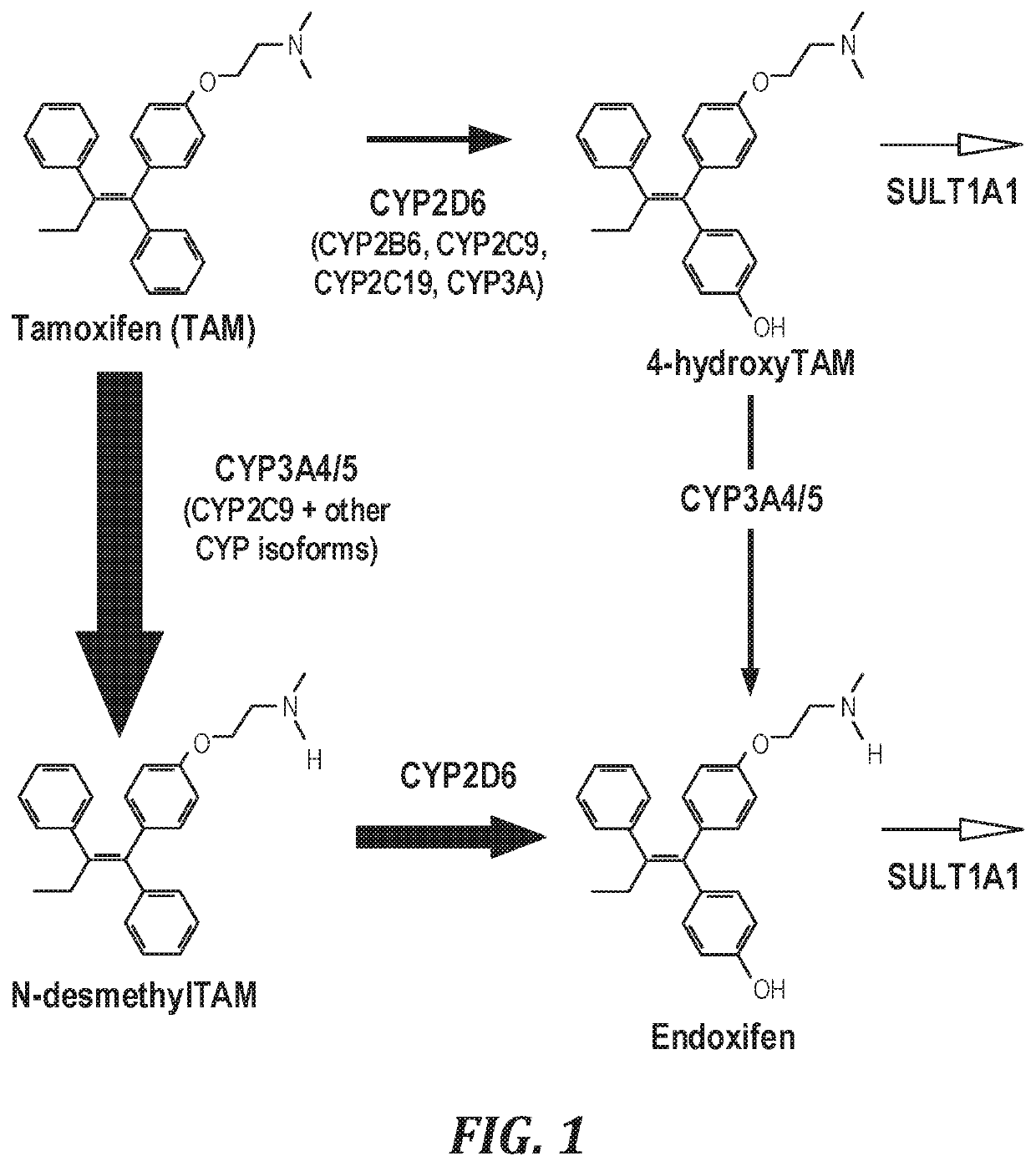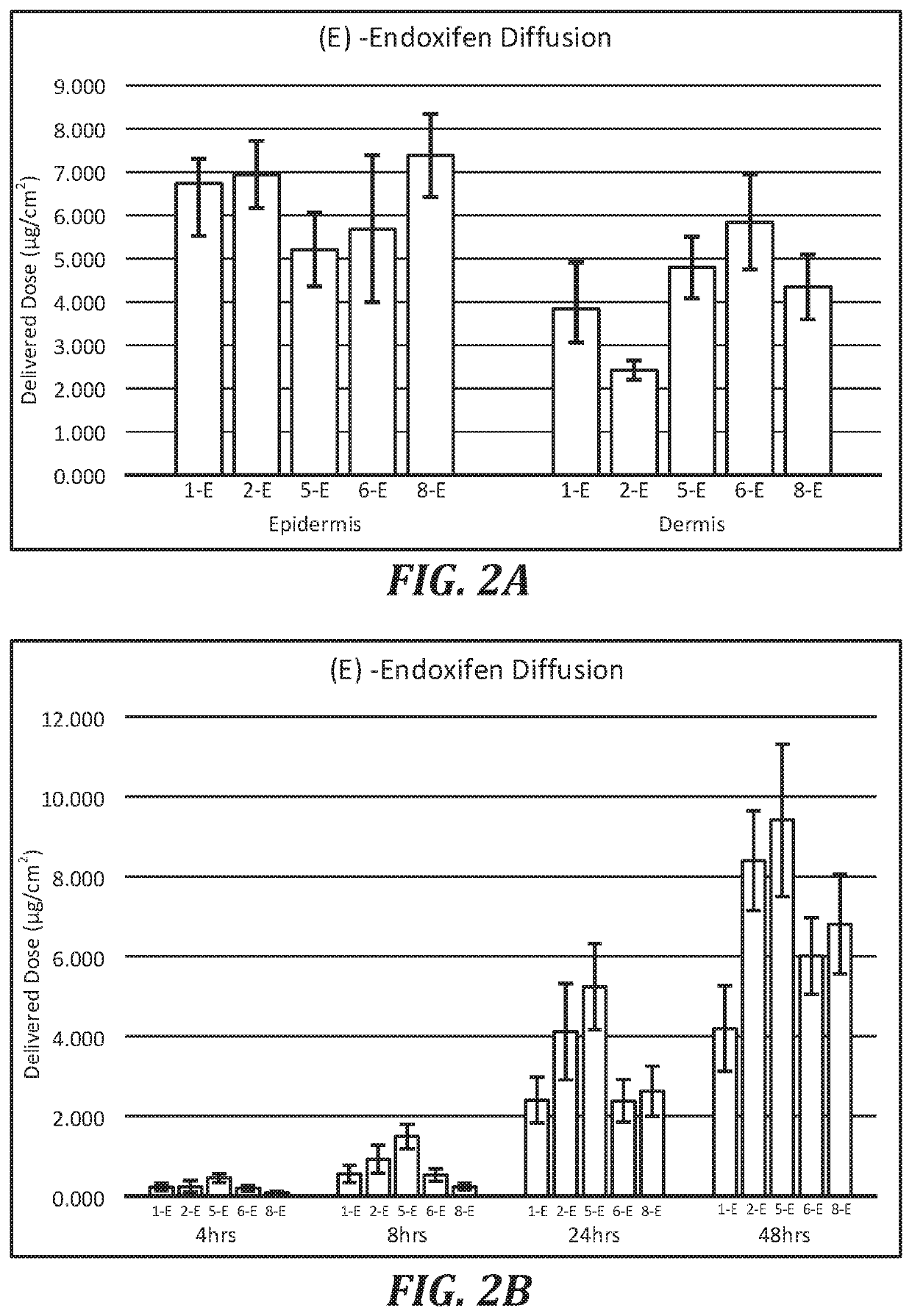Topical compositions
a technology of compositions and compositions, applied in the field oftopical compositions, can solve the problems of severe limitations in the therapeutic options and survival rate, the adverse effects of adjuvant therapy primarily via oral delivery of tamoxifen are known to be severe in some subjects, and the patient remains patient-friendly
- Summary
- Abstract
- Description
- Claims
- Application Information
AI Technical Summary
Benefits of technology
Problems solved by technology
Method used
Image
Examples
example 1
Synthesis of (Z)-Endoxifen and (E) / (Z)-Endoxifen Mixtures
Step 1. Demethylation of [4-[2-dimethylamino)ethoxy]phenyl] (4-hydroxyphenyl)methanone
[0402]
[0403]A suitable 10 L reactor was charged with starting material [4-[2-(dimethylamino)ethoxy]phenyl](4-hydroxyphenyl)methanone, Compound of Formula (I) (0.5 Kg, 1.0 equiv.), DIPEA (1.5 Kg, 6.65 equiv., 3.0 wt. / wt.) and Tetrahydrofuran (5 L, 10 vol. / wt., 8.9 wt. / wt.) under N2 atmosphere. 1-Chloroethyl chloroformate (1.7 Kg, 6.65 equiv., 3.3 wt. / wt.) was added slowly while maintaining the internal temperature at NMT 20° C. The mixture was heated to reflux and stirred at reflux for NLT 12 hr. The mixture was evaporated under reduced pressure at NMT 75° C. until the volume reached the lowest agitateable volume. Methanol (2.5 L, 5 vol. / wt., 4.0 wt. / wt.) was added slowly and the mixture was distilled under reduced pressure at NMT 75° C. until the volume reached the lowest agitateable volume. Methanol (2.5 L, 5 vol. / wt., 4.0 wt. / wt.) was added...
example 2
Relative Solubility of Endoxifen Free Base
[0414](Z)-endoxifen free base was synthesized as described above in Example 1. (Z)-endoxifen was solubilized in various solvents as provided in Table 1, and tested for physical and chemical stability in solution. The solutions were prepared in ˜1 ml batches typically for solubility and stability testing. An excess amount of endoxifen was added into solvents listed in Table 1. The mixture was stirred overnight on a rotisserie at room temperature. The next, day, the suspension was filtered using a syringe filter (0.2 um pore size GHP membrane). The filtrated solution was then analyzed for the concentration of (Z)-endoxifen and (E)-endoxifen as using a validated HPLC-UV method as described below.
TABLE 1Solubility of (Z) and (E)-endoxifen in polar organic solventsSolubility Limit(E)-(Z)-TotalSolventZ / EZ:EendoxifenendoxifenEndoxifenNo.Solvents / CarriersRatio(wt % / wt %)free basefree basefree base1Dimethyl Sulfoxide1.8765:35+++++++++++2Diethyl Sebac...
example 3
Stability of (Z)-Endoxifen Free Base in Polar Organic Solvents
[0418]The stability studies of endoxifen free base in various pure polar organic solvents / MPEs were performed as described below. Accelerated stability studies of (Z)-endoxifen free base in solvents / MPEs were performed over a course of 2 days at 45° C. in both the presence and the absence of human cadaver skin to assess the degree to which the (Z)-endoxifen conversion to (E)-endoxifen by isomerization and or chemical degradation of the endoxifen is accelerated upon contact with skin and skin components. (Z)-Endoxifen solutions at −80% of saturation concentrations were prepared in 1 ml batches in solvents as listed below in the Table 3. The potencies of (Z)-endoxifen and (E)-endoxifen were determined by HPLC-UV analysis as described above. Potency results are shown compared with potencies measured when the sample were stored at the initiation of stability study.
TABLE 3Stability of endoxifen free base in polar organicsolven...
PUM
 Login to View More
Login to View More Abstract
Description
Claims
Application Information
 Login to View More
Login to View More - R&D
- Intellectual Property
- Life Sciences
- Materials
- Tech Scout
- Unparalleled Data Quality
- Higher Quality Content
- 60% Fewer Hallucinations
Browse by: Latest US Patents, China's latest patents, Technical Efficacy Thesaurus, Application Domain, Technology Topic, Popular Technical Reports.
© 2025 PatSnap. All rights reserved.Legal|Privacy policy|Modern Slavery Act Transparency Statement|Sitemap|About US| Contact US: help@patsnap.com



